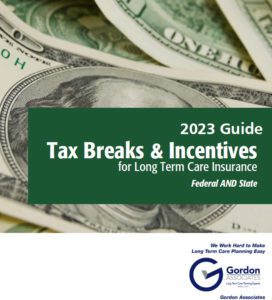If you have a Traditional IRA and/or a Beneficiary IRA, chances are you have plans for the assets. Oftentimes those assets are earmarked to help fund retirement and family legacy. However, an unexpected long term care event can wreck those plans if one is completely self-funding it.
A long term care event is something many families will eventually experience. An unknown variable that may be very expensive, depending on the nature of the event. One approach to protecting those assets in a Traditional IRA and/or Beneficiary IRA is to acquire Long Term Care Insurance (LTCI) rather than fully self-funding. With tax rates currently as low as they are, this is a strategy your clients should consider.
This is not necessarily a new strategy for planning for the consequences of a long term care event, but one that is not considered as much as it should. Please note that what follows is general advice. We are not tax specialists. We recommend you contact a tax specialist with questions or for more details.
A Long Term Event
Needing long term care can be unpredictable – one does not know when a severe illness or injury will occur, how long it will last, how much third-party assistance will be needed and how costly it will be. When care is needed, it typically is very expensive. The cost for long term care (facility or home care) can reach $100,000 or more a year. That amount can easily double if one is needing around the clock home health care. If one plans on funds from a Traditional IRA or Beneficiary IRA to cover these costs, there are at least a couple of issues to consider. First, one may be utilizing assets already earmarked for other planning purposes. And second, you will need to pay taxes at the current rates on the withdrawn funds.
However, if one had previously acquired long term care coverage through the IRA, then the earmarked assets are protected for the intended use and any tax consequences are a known variable rather than an unknown in the future.
How Does It Work?
Here are two ways one could use qualified money to fund a LTCI policy. One, find an insurance company that offers a LTCI which will take a direct transfer from an IRA. Unfortunately, there are not many that do. Or two, transfer the money into an IRA Single Premium Immediate Annuity (SPIA), which can be designed with guaranteed years of term certain to payout (most common is ten years). This can then pay a ten-year paid up premium for a LTCI policy. The payouts (distributions) from the SPIA will be fully taxable to the policyholder as ordinary income, but is spread out over the ten-year period rather than taking the tax hit all in year one. We recommend one utilizes the same insurance company to handle both the SPIA and the LTCI policy.
Beneficiary IRA
Prior to 2020, when one inherited a Traditional IRA, there was no time limit for assets to be liquidated. There was no table consequences if the assets were left in the IRA. A planning strategy many used to leave a legacy for their heirs. This recently changed with the passage of The CARES Act (or Secure Act). The act created a Beneficiary IRA (formerly Inherited IRA). Now, when one inherits a Traditional IRA it becomes a Beneficiary IRA and assets must be liquidated within 10 years. They may be liquidated all at once, every year over ten years or any amount of years. But all the funds need to be completely withdrawn within ten years from the time the IRA is inherited.
There is no penalty for withdrawing assets from a Beneficiary IRA before age 59 ½, since money may be inherited at any age. LTCI is an age-based premium so the younger one is the less expensive the cost. And as a health underwritten product, one is more likely to be insurable at a younger age. Therefore, using funds from a Beneficiary IRA at a younger age to acquire LTCI can be very advantageous. There is no expiration date on a LTCI policy once it’s paid up. One will have the coverage for the rest of their life. In essence, the inherited funds from the Beneficiary IRA, which had time limits for utilization, are now protecting one’s independence, financial future, and family from the consequences of a long term care event for the remainder of one’s life.
Stand-Alone LTCI or Hybrid?
The planning strategies outlined here can help obtain either a Stand-Alone LTCI policy or a Hybrid Asset-Based policy. With Stand-Alone LTCI, the premiums are not guaranteed, but are less expensive than a Hybrid policy. A Hybrid policy has both premium and benefit guarantees that a Stand-Alone policy does not. There are pros and cons to both types of policies. Underwriting is also a big factor when considering company and policy options. LTCI is not one-size-fits-all insurance. Every family has different circumstances and preferences when planning for consequences of long term care. A LTC planning specialist can help determine insurability, review coverage options, and assist with the implementation of the plan.
At Gordon Associates, we have been helping families with their long term care planning (and claims) since 1975. Please contact us for more information.


 To help determine if long-term care (LTC) insurance is right for you, we are offering a FREE informational guide. This is a comprehensive booklet that will answer many of your questions about tax breaks and incentives for LTCI for federal and state taxes.
To help determine if long-term care (LTC) insurance is right for you, we are offering a FREE informational guide. This is a comprehensive booklet that will answer many of your questions about tax breaks and incentives for LTCI for federal and state taxes. To help determine if long-term care (LTC) insurance is right for you, we are offering a FREE informational guide. This is a comprehensive booklet that will answer many of your questions about LTC and assist you with your health care planning.
To help determine if long-term care (LTC) insurance is right for you, we are offering a FREE informational guide. This is a comprehensive booklet that will answer many of your questions about LTC and assist you with your health care planning.